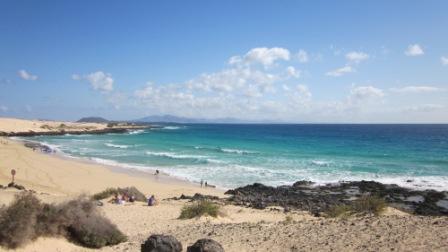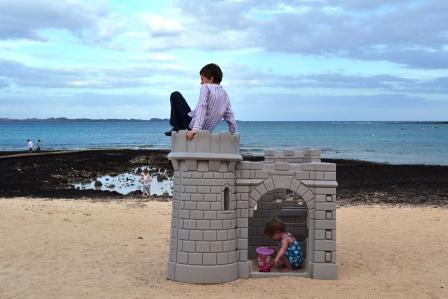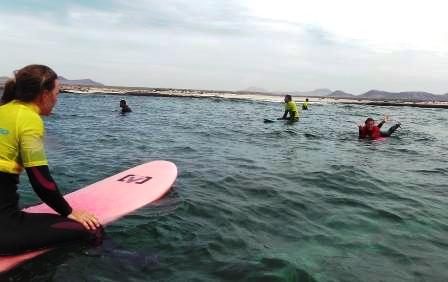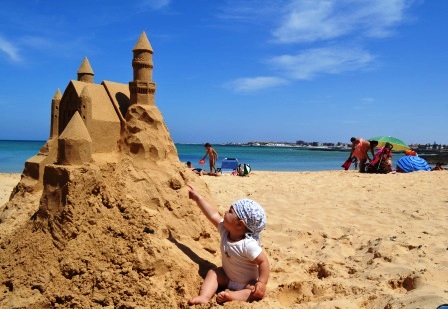People come to Fuerteventura to escape: to escape the cold climate of mainland Europe in the winter. Many don't go back. It was hard for me to encounter a local Majorero here on this Spanish Canary Island, one hundred kilometers off the coast of Africa: unless one considers Albanians, Italians, Brits and Germans to be honorary locals. The waitress of the Cordon Blue tavern over the sea was a Brit who came to visit her daughter's boyfriend's family 16 years ago. She stayed, leaving her own "mean boyfriend" behind in England; her daughter left to study at the university. Then her daughter came back. Now they both are waitresses together. "It's a great life!" the waitress laughed, her hair tossed back in one of the many Fuerteventuran breezes. "It's so easy."
My masseur escaped the northern coast of Spain, where, he scowled, the winters are "so cold."
But he admitted that after six years here, he is a little "bored". "Not much culture," he noted.
I would say, no culture. This is a place where the sea and the windswept dunes predominate, except for the majorera goats randomly perched on the dry plains, producing delicious cheeses, and reminding the tourist that the original name of the island, by the ancient Romans, was Capraria. The architecture is all monolithically modern: concrete stucco homes for vacationers. The stores are geared, for the most part, to the tourist: plastic balls and fins for the beachbum, Gucci and Zara for the dressed.
But if mindless sun, breeze and sea is what you need--which is apparently the case for the dozens of middle-class European families with small children relaxing on the main stretch of sand--this is a great escape.
Plus the food is delicious. So much better than what I could get in Paris. Fresh broiled parrot fish, with accompanying hard boiled red potatoes (papas arugas), and the never-lacking three colorful mojo sauces. Something green, something red, something white. I loved these unusually tasty potatoes, although a new Dutch friend I met on the island positively did not. "They are SO hard!" she said, noting that if I endorsed them in this article she would write in a reader complaint.
Aside from the potatoes, Fuerteventura has a tremendous landscape to offer. It is one of seven Canary Islands, the one that is considered the "best" because it is actually less developed the others. Its desert-scapes over the sea and its far-off brooding mountains create a lone-wolf atmosphere. "Looks like Afghanistan," quipped one "local" here, another Brit who escaped.

But the main reason to come to Fuerteventura: the surf. Anyone here who is not a "local" or a toddler or a parent is per forza a surfer or would-be surfer.
The ocean brims with dozens of bobbing foam boards, all beginners paddling together, vanned in by one of the dozen surf schools.
I personally prefer a deserted beach, and no bopping foam--but it is fun and spring-time sunny. Cariene, my Dutch friend, was so sad when she left to go back home.
"It was so great!" she said dolefully, as she packed up.
If tempted to escape and surf yourself--why not?-two words of advice:
Check with a knowledgeable surfer about whether it is the right season. I did not. When I came, all the waves were wind-swept, so much so, that most of the time, I could not make out a clear crest. I resorted to dodging between my fellow foam-boarders on the white water. Only later was I told, by a "local" (Italian) pizzeria surfer, that April is the wrong season for Fuerteventura. "Not enough wind for good wind waves; but not enough ground swell for swell waves." The time to come is summer or winter.
Second: choose a surf school that actually teaches you to surf. While dozens are heralded as great fun by all who participate (check the stellar web reviews), I only came upon one professional surf school where the teachers actually made the incredible move to accompany the students in the water. "Easydrop", fifty yards from the beach, brand-new, and run by an eccletic group of Germans and Hungarians. I spent my last four days there, and found it an elegant top-notch enterprise, no comparison to the rest, where the teachers sunned themselves on the beach, while their unsuspecting "students" floundered in white water. Zsoka and her husband Miki, the Hungarian co-owners of Easydrop, instructed each student individually, for four hours straight, explaining in careful detail where the foot should go, where the bum should not, always with a beaming smile of encouragement. "Surfing," Zsoka enthused, as we paddled out. "Has no limits! No age limits, no physical limits. It's a lifelong connection to yourself.
In the evening, Miki, with bright teacherly eyes, would review our morning surf with the group, analyzing videos in slow-motion of every wave taken on a huge flat-screen TV in the cozy den of this spotlessly clean surfhouse. He, a former environmental engineer and snow-boarding instructor (hence trained to teach), even rigged up his own contraption, a board roped in the swimming pool, for those of us--like me--who needed to practice their "pop-up." And in case you thought that was enough: lectures on the physics of wave formation (including the Coriolis Force) and how to read the weather forecast followed. After two days of surf instruction, Miki effectively rewired my "muscle memory" to correctly use my left heel.
It is one of the best-run surf schools I have come across in four continents--and a reason in itself to come to Fuerteventura.
Then again, you can also forego surfing, and build sandcastles.


